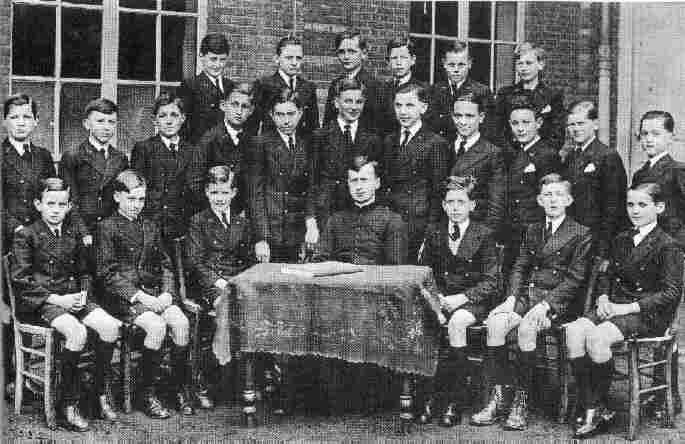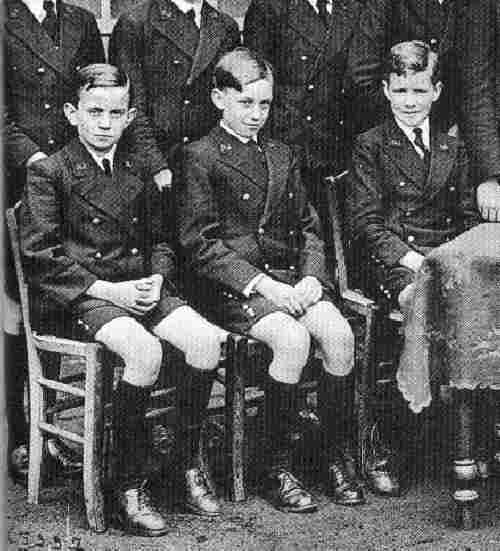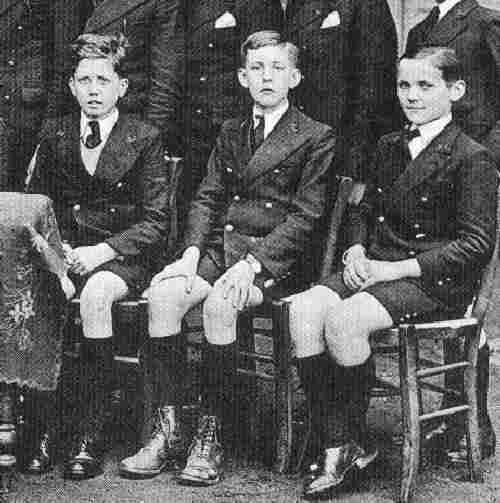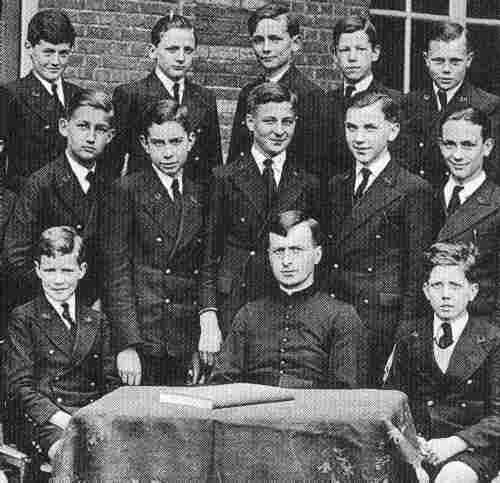
Private Catholic School: St. James

Figure 1.--This photograph taken in 193? shows a class from a private Catholic school, St. James. The boys wear short pants double breasted suits, with miltary like buttons and a "SJ" pin in their lapels. Notoce how the boy on the right has outgrown his suit jacket.
|
HBC is attempting to assess French schoolwear trends. We have assembled a good deal of information on different types of garments, but an accurate assessment of trends over time and conventions remains elusive. Thus HBC is assembling images of invidual schools. One a number of schools have been assesmbled it will enable us to better understand trends over time and accepted conventions. Unfortunately often little information is available on the schools pictured in many available images. HBC will do its best to assess these images. Hopefully our French consultants will be able to add additional details.
Type
St. James is a private Catholic school. The priest confirms that it is a Catholic school. Most Catholic schools in France were at the time single gender schools. The picture appears to show only one class. HBC does not know what the age range at the school is. They could be the older boys in a elementary school or the younger boys in a secondary school. Or the school could have all the year levels.
A French HBC contributor This is obviously a private boarding lycée for wealthy pupils of the bourgeoisie. He writes, "As I know from my family, boys of this social class in the 1930's commonly wore short pants rather late, at least in summer, and had nearly always a tie in secondary school (lycée), even if they were in a school that didn't impose an uniform."
Chronology
The photograph was taken in 193?.

Figure 2.--All the boys at St. James wear identical double breasted suits. The uniformity shows that considerable attention is given to the uniform at the school. Note the "SJ" pins on the lapels. It is not known, howeverm if this was the dress uniform or the uniform worn daily.
|
Class
The photograph is "une classe de quatrième," that
means a class of pupils in the third year of secondary school. The boys are normally about 13 years
old. The boys at the back look a little older, but this may be simply the normal variation in boys at this age or the classes at the school may be grouped by ability rather than chronolgical age.
Teacher
The teacher is a Roman Catholic priest. There was religious instruction in French state schools, but a priest would not have been a form teacher unless it was a Catholic school.
Clothing
Most French schools by the 1930s did not require uniforms. Some, but not all, private French schools did require uniforms. The boys in this class are wearing such a closely regulated uniform that there is no diversity to discuss only the style of the uniform.
Cap
None of the boys wear caps, so it is not known what kind of headgear they wore. Given the fact that th schoolmhad such strictuniform regulations, almpost certainly theu would have had some sort of cap to go with it.
Smocks
None of the boys wear smocks. Smocks were still quite common, although not universal, for French boys in the 1930s. HBC does not know if they might wear smocks during a normal school day or if the younger boys at the school wore smocks.
Jackets
All of the boys wear identical doublr breasted jackets. I'm not sure about the color, it was either black or navy blue. The lapels of the jacket are quite large. They have bright brass buttons, giving them a militaryblook, especially with the "SJ" pins in both lapels. The lapels are so large that you can hardly see the ties the boys are wearing. A few of the boys on the right wear natty hankerchieds in the breast pocket. The jackets suggest that these boys are not new boys at the school. Note that the sleeves severa boys are wearing are well above the elbows. Parents usually buy school uniforms a little large. Some of these boys have just about grown out of their uniform and will soon need new jackets.

Figure 3.--The boys not only wear brass buttons on their jackets, but there are buttons on the hem of their short pantss, like old-fashioned kneepants. Note the boot-like shoes the boy in the middle wears, the one major difference among the boys.
|
Pants
All of the boys appear to be wearing short pants, although it is not claer what the older boys at the back are wearing. It is likely that they also wear short pants, but there is no way of knowing for sure. The boys not only wear brass buttons on their jackets, but there are buttons on the hem of their shorts, like old-fashioned kneepants. This seems quite unusual, especially as they are brass buttoms that stand out. This effect adds to the rather military style of the uniform. It was not common for French schools to require their students to wear short pants. Most boys wore them, but mostschools left it up to the parents. Given the uniformity here, St. James must have required the boys to wear short pants.
Sweaters
Only one of the boys wears is obviously wearing a sweater. It looks to be a white or light colored sweater. Other boys may alsi have sweatrs colored over by their jackets.
Shirts
All of the boys wear white shirts.
Ties
French boys often did not wear ties to school. It is unclear if boys at St. James wore ties for daily lessons. The ties worn by the boys are dark solid colored ties. I am not sure about the color, but it looks to be about the same color as the suit.
Socks
All of the boys wear mathing dark kneesocks. This is a little unusual, as I have not noted French boys commonly wearing dark suits and matching knee socksd. This was more common in America. French boys did commonly wear kneesocks, especially with suits, but dark kneesocks were not common.
Footwear
The foot wear is, other than sweaters, the one area that was not a perscribed part of the uniform. Mpost boys appear to werar black oxford cut shoes, but one boys wear the highcut boot-like shoes that French boys still wore in the 1930s.

Figure 4.--It is not clear if the boys in the back rows were wearing long or short pants, but HBC believes all the boys are probably wearing shorts.
|
Hair Styles
All of the boys wear similar length hair styles. None wear hair over their ears, but none have especially short cuts.
Christopher Wagner
histclo@lycosmail.com
Related Chronolgy Pages in the Boys' Historical Web Site
[Main Chronology Page]
[The 1840s]
[The 1850s]
[The 1860s]
[The 1870s]
[The 1880s]
[The 1890s]
[The 1900s]
[The 1910s]
[The 1920s]
[The 1930s]
Navigate the Boys' Historical Clothing School Uniform Pages
[Main School Uniform Page]
[Australia]
[England]
[France]
[Germany]
[Italy]
[Japan]
[New Zealand]
[Scotland]
[United States]
Created: February 18, 2000
Last updated: February 21, 2000





